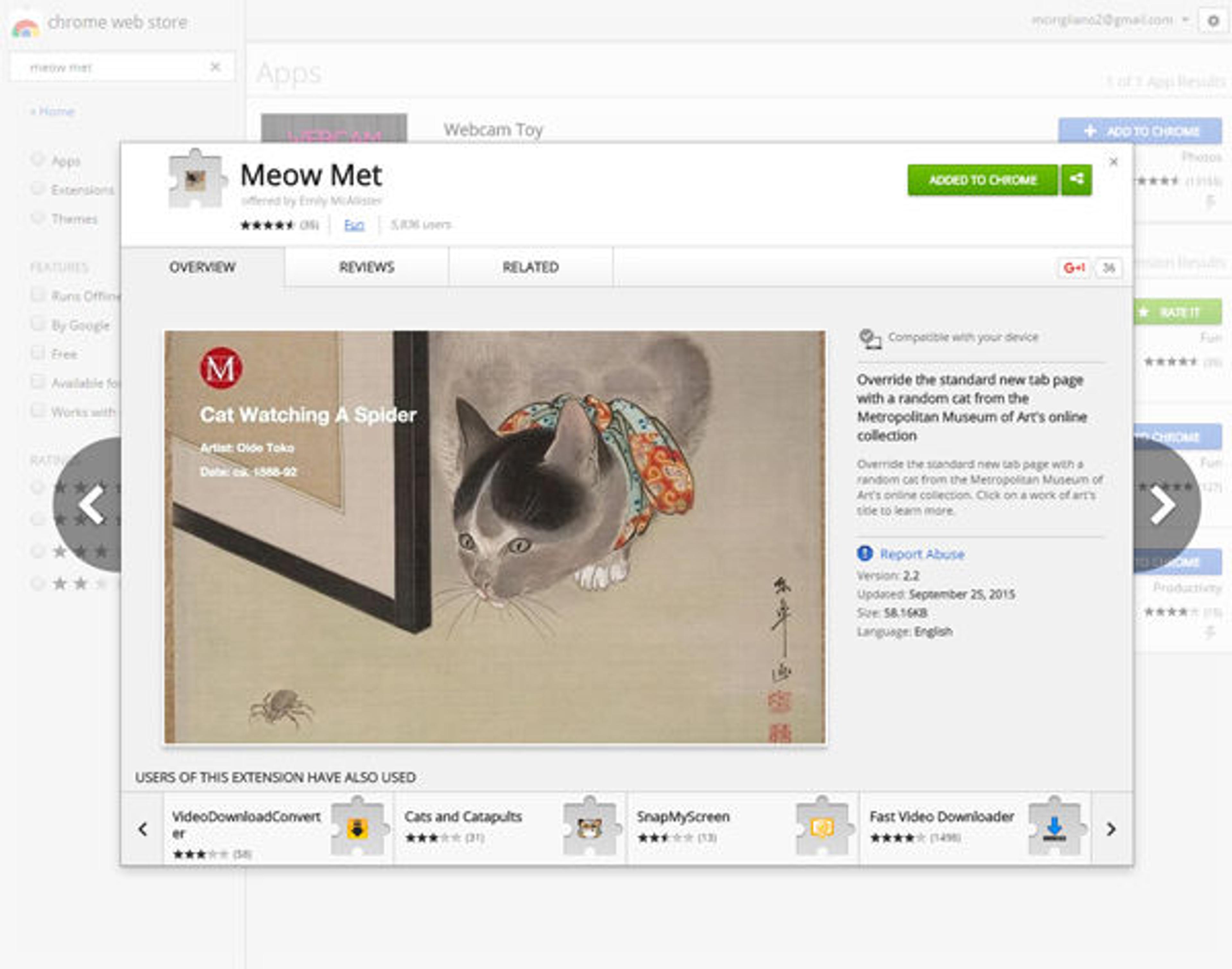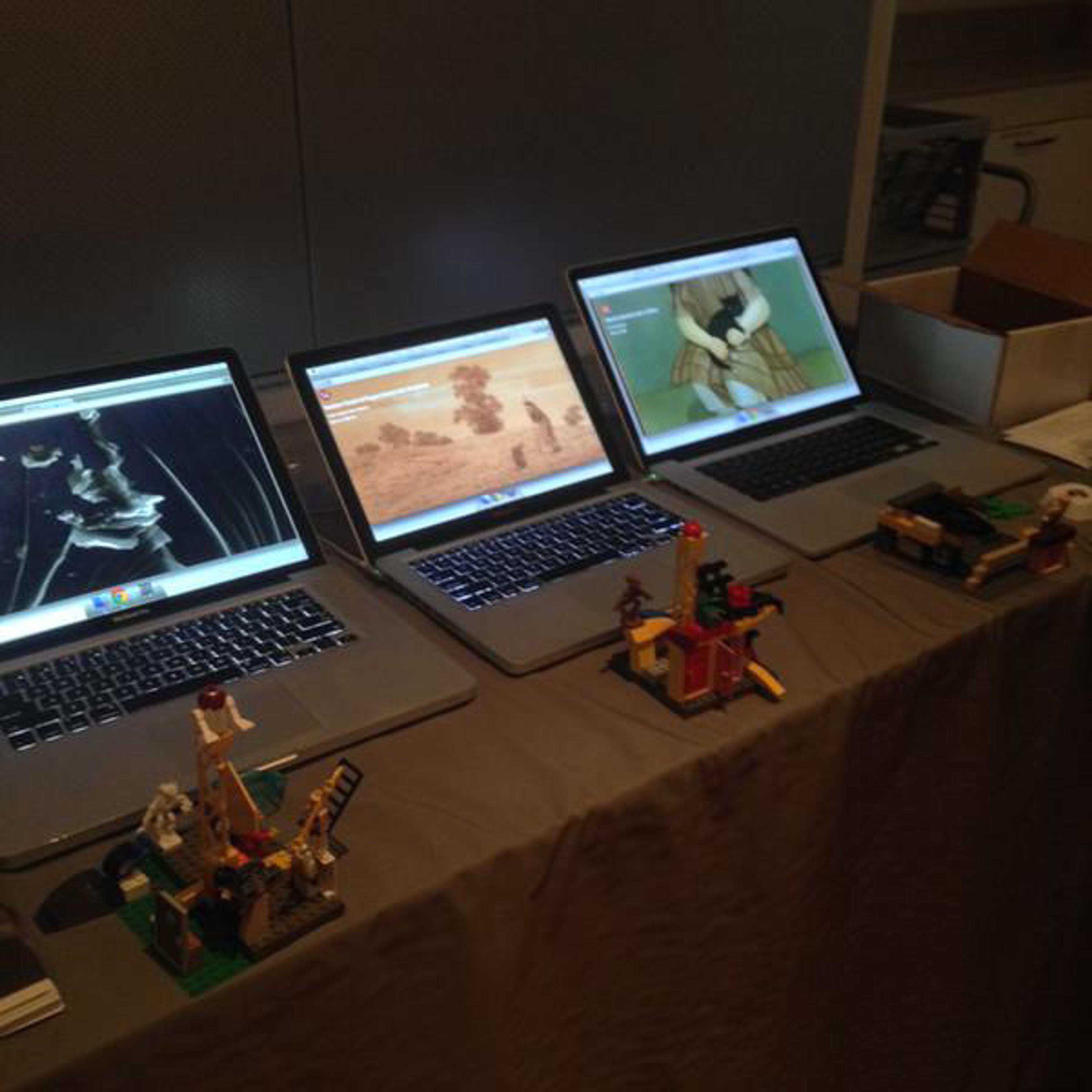Close-Ups, Special Scans, and Purrfect Artworks: The Met Chrome Extensions

A screenshot of Meow Met on the Google Chrome Web Store
From Marco Castro Cosio, Manager of MediaLab:
The MediaLab is a research and development hub at the Met that explores, probes, pilots, and prototypes emerging technology within the Museum context. We are interested in finding new ways to experience the Met's collection by bringing together a diverse and collaborative team of research interns and volunteers from the tech, design, and art communities. The Met Chrome Extensions, which populate new browser tabs with a full-screen, randomly selected image from the Met's Collection Online, have been a great way for the MediaLab and the Met to have conversations with new audiences and learn from them. Please enjoy the experiments, and let us know what you think. Keep an eye out for more work.
About the Project
«The Met Chrome Extensions deliver an unexpected and intriguing experience each time a Google Chrome user opens a new tab by sharing a breathtaking image from the Met's Collection Online, fostering daily interaction and encouraging curiosity. Three distinct prototypes include the popular Meow Met, a peek into the extravagant lives of cats at the Met; The Met Magnified, which features extreme, abstracted close-ups of object details; and Micro Met, which explores ethereal perspectives of objects captured using a scanning electron microscope (SEM).»


Screenshots of new tabs opened after adding The Met Magnified (top) and Micro Met (bottom) to Google Chrome
The Process
On my first day at the MediaLab, I realized that working in such a creative, experimental space would make narrowing my focus and finding just one project to work on throughout the semester a significant challenge. My original project proposal focused on exploring color palettes, but as I began developing this color-interpretation tool, the allure of the galleries continued to pull me away from my desk. I wondered if it would be possible to explore guerilla-style filmmaking set in the Met, similar to the production of Escape from Tomorrow, an indie film illegally shot on the fly in Disneyland. Or, what if I could create some sort of mystery or game, like the Jejune Institute from the indie documentary The Institute.
While exploring the potential for a film set in the Met, I started to wonder about individual experiences. What are people listening to as they wander? Could we create a mixing tool to integrate the Museum's Audio Guide with personal music playlists, or find complementary podcasts or wordless audio beds matched to specific exhibits? I tried listening to "Color Walking," a Radiolab piece on William S. Burroughs's concept of "color walks," as I wandered around the Modern and Contemporary art galleries. This brought me back to color tracking, but more importantly, it brought me to this concept of unexpected, hyper-specific relationships between museum objects.
As my color walk led me through the European Paintings galleries, I started noticing the recurring presence of white-spotted hunting dogs depicted in paintings. There are a lot of dogs in the Met, which of course raised the question: Are there any cats? I started counting, taking photos of each cat I could find, beginning with Hans Süss von Kulmbach's Portrait of a Young Man; (reverse) Girl Making a Garland. I found about ten before I realized this was a job for scrapi, an application program interface that collects object information from the Met's Collection Online. I used scrapi to grab an initial batch of museum objects that had the term "cat" associated with them.

Hans Süss von Kulmbach (German, ca. 1480–1522). Portrait of a Young Man; (reverse) Girl Making a Garland, ca. 1508. Oil on poplar; 7 x 5 1/2 in. (17.8 x 14 cm). The Metropolitan Museum of Art, New York, Gift of J. Pierpont Morgan, 1917 (17.190.21)
I'll admit I'm biased here as a cat person, and my interest in comparing dogs throughout the Met quickly vanished as I realized how long held and global the human fascination with cats has been. I wasn't sure where I was going with this; I only knew it was amazing to see a cat batting at a woman's flowing dress from the seventeenth century, or chasing a butterfly in Japan. It felt like experiencing early prerequisites for Internet cat videos.
Meanwhile, as a side project, I decided to start developing a Chrome extension for the Met that was based on one I love, Earth View from Google Earth, which features a different beautiful, abstracted satellite view of the Earth every time you open a new tab. I hoped to create something similar for the Met in which every new tab would feature a different work of art. As I was developing the project, though, the Google Cultural Institute released the excruciatingly similar Google Art Project extension, which features artworks from the Met and other museums. Nonetheless, I presented a prototype of the Chrome extension I developed at one of our monthly staff and industry presentations, and was met with great feedback and encouragement to continue iterating.
The MediaLab interns later visited the Met's Scientific Research Department—mostly just to check out what kind of incredible things were happening down there. We looked at high-powered lasers used for cleaning Museum objects; equipment for testing for mold, decay, or bugs; and tools for determining authenticity. We also viewed works of art that had been studied using a scanning electron microscope (SEM) in order to understand their material composition.
The images the scans produced were breathtaking, many resembling works of art themselves, and a fellow intern suggested I use these images in my Chrome extension. The scans had never before been released, instead existing only in the Met's basement, but they provided a beautiful, new perspective on familiar works. I jumped at the idea, and began collaborating with Marco Leona, David H. Koch Scientist in Charge, and Associate Research Scientist Federico Carò to match the SEM imagery with the corresponding objects in the Met's Collection Online.
This led to the expansion of the Chrome extension from a side project to three full-time projects; I set out to develop an SEM imagery version, an abstracted detail version, and a version featuring the imagery of cats in the Met that I had been obsessively collecting. I used Chrome DevTools to walk through the necessary steps of creating a Chrome extension, and for the prototypes, I ended up creating individual html pages rather than pulling from scrapi because I needed to further curate the objects, particularly ones tagged with "cat" or "kitten."
The Launch
As I developed and refined each of the extensions, I constantly asked for feedback on which version people would actually use, and never came to any kind of consensus. So, when I launched all three Chrome extensions at the May 2015 MediaLab Expo, I was determined to find out which version was most likely to succeed if publicly available, and I created a voting system. After testing each version—Meow Met, Micro Met, and The Met Magnified—users could grab a Lego piece from my collection, and add it to an ever-growing tower in front of their favorite Chrome extension. If anything, the opportunity to play with Legos increased interest among the crowd.

Some of the Lego creations made by visitors who placed a vote on their favorite Chrome extension
In the end, it was a very close tie—much like I had been experiencing throughout the semester—but Meow Met slightly edged out the competitors. Check it out, and feel free to send along your feedback. I would love to hear your thoughts. Over and meowt!

Emily presenting The Met Chrome Extensions to remote visitors, including Paola Antonelli, Director of R&D at the MoMA, using the Beam Telepresence Robot
Emily McAllister
Emily McAllister was formerly a MediaLab intern in the Digital Media Department. She is an award-winning filmmaker and graduate of the inaugural one-year MBA program at Cornell Tech (2015). Emily also received her BA from Cornell University (2011), majoring in Economics and Film, with a minor in Visual Studies. She spent four years producing independent films in New York before returning to Cornell Tech to explore how digital platforms and interactive storytelling are shifting media creation and distribution. Her first feature film as a producer, Maidentrip, premiered at SXSW 2013, winning the Audience Award. She continues to produce feature documentaries, including the upcoming HBO release The Diplomat.